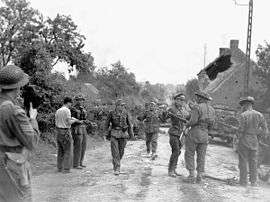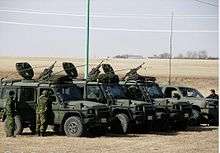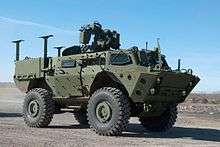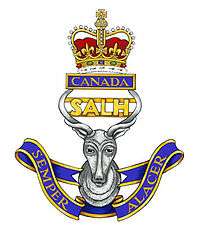South Alberta Light Horse
| The South Alberta Light Horse | |
|---|---|
|
The South Alberta Light Horse cap badge | |
| Active | 1885, 1905–present |
| Country | Canada |
| Branch | Primary Reserve (Militia) |
| Type | Originally light cavalry/mounted infantry, now armoured |
| Role | Armoured reconnaissance |
| Size | Regiment |
| Part of | 41 Canadian Brigade Group |
| Garrison/HQ | Medicine Hat (A Squadron) and Edmonton (B Squadron) |
| Nickname(s) | Sally Horse / Alberta's Regiment |
| Motto(s) | Semper alacer (Always brisk) |
| Colors | Red, yellow and blue |
| March | "A Southerly Wind and a Cloudy Sky" |
| Mascot(s) | Heine the Pony |
| Anniversaries | Official birthday 3 July 1905 |
| Website |
www |
| Commanders | |
| Current commander | LCol Troy Steele CD |
| Colonel-in-Chief | HRH the Countess of Wessex |
| Honorary colonel | John Ferguson |
| Honorary lieutenant-colonel | Angus Watt |
| Regimental sergeant-major | CWO Chuck Howie CD |
| Notable commanders |
LCol A.H. Bell CMG DSO (31st Bn) 1914 |
| Abbreviation | SALH |
The South Alberta Light Horse, or SALH, is a Reserve armoured reconnaissance regiment unit of the Canadian Army based in Medicine Hat, Edmonton, and Lethbridge, Alberta. The SALH is part of 3rd Canadian Division's 41 Canadian Brigade Group. The "Light Horse" designation comes from its light cavalry and mounted infantry origins.
Victoria Cross
History
Early history
The South Alberta Light Horse traces its beginnings to the period of the Riel Rebellion of 1885. During this conflict The Rocky Mountain Rangers

of Fort Macleod with 150 officers and men were tasked with the protection of the area ranging from the U.S. border to High River and from the Rockies to Medicine Hat. The RMR saw no action during their three months of existence during the rebellion, and the SALH carries the battle honour "North West Canada, 1885" on their colours.
This irregular light cavalry unit is seen as the true genesis of the regiment. The 15th Light Horse, the official direct ancestor of the SALH, was raised in Calgary on July 3, 1905. From this point until the mid-1950s the regiment's history can be described as a series of complicated amalgamations and redesignations of Alberta army reserve units of all arms until the regiment as it is now was formed in Calgary in 1954. At the beginning of the First World War, the Alberta militia units destined to become part of SALH were four cavalry regiments – 15th Light Horse in Calgary, 19th Alberta Dragoons in Edmonton, 21st Alberta Hussars in Medicine Hat and 23rd Alberta Rangers in Fort Macleod – and two infantry regiments – 101st Regiment "Edmonton Fusiliers" and 103rd Regiment "Calgary Rifles".[1]
Lineage of the South Alberta Light Horse, 1885–1914
| Lineage of the South Alberta Light Horse, 1885–1914 | |||||||||||||||||||||||||||||||||||||||||||||||||||||||||||||||||||||||||||||||||||||||||||||||||||||||||||||||||||||||||||||||||||||||||||||||||||||||||||||||||||||||||||||||||||||||||||||||||||||||||||||||||||||||||||||||||||||||||||||||||||||||||||||||||||||||||||||||||||||||||||||||||||||||||||||||||||||||||||||||||||||||||||||||||||||||||||||||||||||||||||||||||||||||||||||||||||||||||||||||||||||||||||||||||||||||||||||||||||||||||||||||||||||||||||||||||||||||||||||||||||
|---|---|---|---|---|---|---|---|---|---|---|---|---|---|---|---|---|---|---|---|---|---|---|---|---|---|---|---|---|---|---|---|---|---|---|---|---|---|---|---|---|---|---|---|---|---|---|---|---|---|---|---|---|---|---|---|---|---|---|---|---|---|---|---|---|---|---|---|---|---|---|---|---|---|---|---|---|---|---|---|---|---|---|---|---|---|---|---|---|---|---|---|---|---|---|---|---|---|---|---|---|---|---|---|---|---|---|---|---|---|---|---|---|---|---|---|---|---|---|---|---|---|---|---|---|---|---|---|---|---|---|---|---|---|---|---|---|---|---|---|---|---|---|---|---|---|---|---|---|---|---|---|---|---|---|---|---|---|---|---|---|---|---|---|---|---|---|---|---|---|---|---|---|---|---|---|---|---|---|---|---|---|---|---|---|---|---|---|---|---|---|---|---|---|---|---|---|---|---|---|---|---|---|---|---|---|---|---|---|---|---|---|---|---|---|---|---|---|---|---|---|---|---|---|---|---|---|---|---|---|---|---|---|---|---|---|---|---|---|---|---|---|---|---|---|---|---|---|---|---|---|---|---|---|---|---|---|---|---|---|---|---|---|---|---|---|---|---|---|---|---|---|---|---|---|---|---|---|---|---|---|---|---|---|---|---|---|---|---|---|---|---|---|---|---|---|---|---|---|---|---|---|---|---|---|---|---|---|---|---|---|---|---|---|---|---|---|---|---|---|---|---|---|---|---|---|---|---|---|---|---|---|---|---|---|---|---|---|---|---|---|---|---|---|---|---|---|---|---|---|---|---|---|---|---|---|---|---|---|---|---|---|---|---|---|---|---|---|---|---|---|---|---|---|---|---|---|---|---|---|---|---|---|---|---|---|---|---|---|---|---|---|---|---|---|---|---|---|---|---|---|---|---|---|---|---|---|---|---|---|---|---|---|---|---|---|---|---|---|---|---|---|---|---|---|---|---|---|---|---|---|---|---|---|---|---|---|---|---|---|---|---|---|---|---|---|---|---|---|---|---|---|---|---|---|---|---|---|---|---|---|---|---|---|---|---|---|---|---|---|---|---|---|---|---|---|---|---|---|---|---|---|---|---|
| |||||||||||||||||||||||||||||||||||||||||||||||||||||||||||||||||||||||||||||||||||||||||||||||||||||||||||||||||||||||||||||||||||||||||||||||||||||||||||||||||||||||||||||||||||||||||||||||||||||||||||||||||||||||||||||||||||||||||||||||||||||||||||||||||||||||||||||||||||||||||||||||||||||||||||||||||||||||||||||||||||||||||||||||||||||||||||||||||||||||||||||||||||||||||||||||||||||||||||||||||||||||||||||||||||||||||||||||||||||||||||||||||||||||||||||||||||||||||||||||||||
History 1914–1938

In the First World War, the Canadian militia units were not mobilized, but instead new units were formed from volunteers from the militia and new recruits. The militia units generally became organizations for recruiting, induction and preliminary training.
The 19th Alberta Dragoons recruited the 1st Divisional Cavalry Squadron, CEF, which landed in France in February 1915. After other divisions joined the 1st Canadian Division in France and the Canadian Corps was formed, the squadron was attached to the corps and became A Squadron, Canadian Light Horse, CEF.[1] The troopers of this squadron wore 19th Alberta Dragoon badges throughout the war.[2]
Also recruited by SALH's predecessors were three regiments of Canadian Mounted Rifles (CMR): the 3rd, 12th and 13th.

The 3rd Regiment, Canadian Mounted Rifles, CEF, was mobilized at Medicine Hat and landed in France in September 1915 as part of the 1st CMR Brigade. At the end of 1915, the CMR units in France were converted from two cavalry brigades (six regiments) into one infantry brigade (four battalions). The troopers of the 3rd Regiment were split up, half going to the 1st CMR Battalion and half to the 2nd CMR Battalion; both these battalions fought in the 3rd Canadian Division.[3] The 12th and 13th Regiments CMR were broken up for reinforcements in England.[1]
The SALH also counts a First World War artillery unit as an ancestor: 22nd (Howitzer) Battery, CFA, CEF. The battery landed in France in January 1916, where it served as part of the 2nd Canadian Division until the end of the war.[1]

Of the eight infantry battalions recruited by the SALH's predecessors, only one entered combat as a unit. The 31st Battalion, CEF, landed in France in September 1915 with the 2nd Canadian Division. It was awarded 22 battle honours, including such notable actions as Vimy and Passchendaele. The other seven battalions – 9th, 66th (Edmonton Guards), 113th (Lethbridge Highlanders), 138th (Edmonton), 175th (Medicine Hat), 187th (Central Alberta) and 202nd (Sportsman's) – were broken up for reinforcements in England.[1]
The 31st Battalion (part of the 6th Infantry Brigade) participated in the first tank attack in history at the Battle of Flers-Courcelette on 15 September 1916,[4] while A Squadron, Canadian Light Horse, made the last cavalry charge in Canadian history at the battle of Iwuy on 10 October 1918.[5] This means that among the predecessor units of the SALH, one participated in the first military operation involving the tank and another mounted the last cavalry charge in Canadian history.
| Unit | Formed | Arrived France | Disbanded or Absorbed |
Notes | Perpetuation |
|---|---|---|---|---|---|
| 1914: 1st Divisional Cavalry Squadron, CEF 1916: A Squadron, Canadian Corps Cavalry Regiment, CEF 1917: A Squadron, Canadian Light Horse, CEF |
August 10, 1914 | February 12, 1915 | November 6, 1920 | Part of the Canadian Corps | 19th Alberta Dragoons |
| 1914: 22nd Battery, CEF 1915: 30th (Howitzer) Battery, CFA, CEF 1915: 22nd (Howitzer) Battery, CFA, CEF |
August 10, 1914 | January 19, 1916 | October 23, 1920 | In March 1915, absorbed by the Canadian Reserve Artillery Brigade, CEF, then re-formed in September. Part of 6th (Howitzer) Brigade, CFA, CEF | 22nd Battery, CFA |
| 1914: 9th Battalion, CEF 1915: 9th Reserve Infantry Battalion, CEF |
August 10, 1914 | N/A | September 15, 1917 | The Edmonton Fusiliers | |
| 3rd Regiment, Canadian Mounted Rifles, CEF | November 7, 1914 | September 22, 1915 | December 31, 1915 | Part of the 1st Canadian Mounted Rifles Brigade. Absorbed by the 1st and 2nd Battalions, Canadian Mounted Rifles, CEF | 1st Regiment, The Alberta Mounted Rifles |
| 31st Battalion, CEF | November 7, 1914 | September 18, 1915 | August 30, 1920 | Part of 6th Infantry Brigade, 2nd Canadian Division | The Alberta Regiment |
| 12th Regiment, Canadian Mounted Rifles, CEF | March 15, 1915 | N/A | February 3, 1916 | Absorbed by the Canadian Cavalry Depot, CEF | 15th Canadian Light Horse |
| 1915: 13th Regiment, Canadian Mounted Rifles, CEF 1916: 13th "Overseas" Canadian Mounted Rifles Battalion, CEF |
March 15, 1915 | N/A | July 19, 1916 | Absorbed by various units | 2nd Regiment, The Alberta Mounted Rifles |
| 66th "Overseas" Battalion, CEF | April 20, 1915 | N/A | July 7, 1916 | Absorbed by the 9th Reserve Battalion, CEF | The Edmonton Fusiliers |
| 113th "Overseas" Battalion, CEF | December 22, 1915 | N/A | October 8, 1916 | Absorbed by the 17th Reserve Battalion, CEF | The South Alberta Regiment |
| 138th "Overseas" Battalion, CEF | December 22, 1915 | N/A | December 8, 1916 | Absorbed by the 128th "Overseas" Battalion, CEF | The Edmonton Fusiliers |
| 175th "Overseas" Battalion, CEF | July 15, 1916 | N/A | January 10, 1917 | Absorbed by the 21st Reserve Battalion, CEF | The South Alberta Regiment |
| 187th "Overseas" Battalion, CEF | July 15, 1916 | N/A | January 20, 1917 | Absorbed by the 21st Reserve Battalion, CEF | The South Alberta Regiment |
| 202nd "Overseas" Battalion, CEF | July 15, 1916 | N/A | May 27, 1917 | Absorbed by the 9th Reserve Battalion, CEF | The Edmonton Fusiliers |
The period between the world wars saw two major reorganizations of the Canadian Militia, the first from 1920 to 1924 and the second from 1935 to 1936. By the outbreak of the Second World War, the ancestors of the SALH were two cavalry regiments (15th Alberta Light Horse in Calgary and 19th Alberta Dragoons in Edmonton) an independent artillery battery (22nd Field Battery, RCA, in Gleichen) and two infantry battalions (the Edmonton Fusiliers and the South Alberta Regiment in Medicine Hat).[1]
Lineage of the South Alberta Light Horse, 1918–1939
| Lineage of the South Alberta Light Horse, 1918–1939 | ||||||||||||||||||||||||||||||||||||||||||||||||||||||||||||||||||||||||||||||||||||||||||||||||||||||||||||||||||||||||||||||||||||||||||||||||||||||||||||||||||||||||||||||||||||||||||||||||||||||||||||||||||||||||||||||||||||||||||||||||||||||||||||||||||||||||||||||||||||||||||||||||||||||||||||||||||||||||||||||||||||||||||||||||||||||||||||||||||||||||||||||||||||||||||||||||||||||||||||||||||||||||||||||||||||||||||||||||||||||||||||||||||||||||||||||||||||||||||||||||||||||||||||||||||||||||||||||||||||||||||||||||||||||||||||||||||||||||||||||||||||||||||||||||||||||||||||||||||||||||||||||||||||||||||||||||||||||||||||||||||||||||||||||||||||||||||||||||||||||||||||||||||||||||||||||||||||||||||||||||||||||||||||||||||||||||||||||||||
|---|---|---|---|---|---|---|---|---|---|---|---|---|---|---|---|---|---|---|---|---|---|---|---|---|---|---|---|---|---|---|---|---|---|---|---|---|---|---|---|---|---|---|---|---|---|---|---|---|---|---|---|---|---|---|---|---|---|---|---|---|---|---|---|---|---|---|---|---|---|---|---|---|---|---|---|---|---|---|---|---|---|---|---|---|---|---|---|---|---|---|---|---|---|---|---|---|---|---|---|---|---|---|---|---|---|---|---|---|---|---|---|---|---|---|---|---|---|---|---|---|---|---|---|---|---|---|---|---|---|---|---|---|---|---|---|---|---|---|---|---|---|---|---|---|---|---|---|---|---|---|---|---|---|---|---|---|---|---|---|---|---|---|---|---|---|---|---|---|---|---|---|---|---|---|---|---|---|---|---|---|---|---|---|---|---|---|---|---|---|---|---|---|---|---|---|---|---|---|---|---|---|---|---|---|---|---|---|---|---|---|---|---|---|---|---|---|---|---|---|---|---|---|---|---|---|---|---|---|---|---|---|---|---|---|---|---|---|---|---|---|---|---|---|---|---|---|---|---|---|---|---|---|---|---|---|---|---|---|---|---|---|---|---|---|---|---|---|---|---|---|---|---|---|---|---|---|---|---|---|---|---|---|---|---|---|---|---|---|---|---|---|---|---|---|---|---|---|---|---|---|---|---|---|---|---|---|---|---|---|---|---|---|---|---|---|---|---|---|---|---|---|---|---|---|---|---|---|---|---|---|---|---|---|---|---|---|---|---|---|---|---|---|---|---|---|---|---|---|---|---|---|---|---|---|---|---|---|---|---|---|---|---|---|---|---|---|---|---|---|---|---|---|---|---|---|---|---|---|---|---|---|---|---|---|---|---|---|---|---|---|---|---|---|---|---|---|---|---|---|---|---|---|---|---|---|---|---|---|---|---|---|---|---|---|---|---|---|---|---|---|---|---|---|---|---|---|---|---|---|---|---|---|---|---|---|---|---|---|---|---|---|---|---|---|---|---|---|---|---|---|---|---|---|---|---|---|---|---|---|---|---|---|---|---|---|---|---|---|---|---|---|---|---|---|---|---|---|---|---|---|---|---|---|---|---|---|---|---|---|---|---|---|---|---|---|---|---|---|---|---|---|---|---|---|---|---|---|---|---|---|---|---|---|---|---|---|---|---|---|---|---|---|---|---|---|---|---|---|---|---|---|---|---|---|---|---|---|---|---|---|---|---|---|---|---|---|---|---|---|---|---|---|---|---|---|---|---|---|---|---|---|---|---|---|---|---|---|---|---|---|---|---|---|---|---|---|---|---|---|---|---|---|---|---|---|---|---|---|---|---|---|---|---|---|---|---|---|---|---|---|---|---|---|---|---|---|---|---|---|---|---|---|---|---|---|---|---|---|---|---|---|---|---|---|---|---|---|---|---|---|---|---|---|---|---|---|---|---|---|---|---|---|---|---|---|---|---|---|---|---|---|---|---|---|---|---|---|---|---|---|---|---|---|---|---|---|---|---|---|---|---|---|---|---|---|---|---|---|---|---|---|---|---|---|---|---|---|---|---|---|---|---|---|---|---|---|---|---|---|---|---|---|---|---|---|---|---|---|---|---|---|---|---|---|---|---|---|---|---|---|---|---|---|---|---|---|---|---|---|---|---|---|---|---|---|---|---|---|---|---|---|---|---|---|---|---|---|---|---|---|---|---|---|---|
| ||||||||||||||||||||||||||||||||||||||||||||||||||||||||||||||||||||||||||||||||||||||||||||||||||||||||||||||||||||||||||||||||||||||||||||||||||||||||||||||||||||||||||||||||||||||||||||||||||||||||||||||||||||||||||||||||||||||||||||||||||||||||||||||||||||||||||||||||||||||||||||||||||||||||||||||||||||||||||||||||||||||||||||||||||||||||||||||||||||||||||||||||||||||||||||||||||||||||||||||||||||||||||||||||||||||||||||||||||||||||||||||||||||||||||||||||||||||||||||||||||||||||||||||||||||||||||||||||||||||||||||||||||||||||||||||||||||||||||||||||||||||||||||||||||||||||||||||||||||||||||||||||||||||||||||||||||||||||||||||||||||||||||||||||||||||||||||||||||||||||||||||||||||||||||||||||||||||||||||||||||||||||||||||||||||||||||||||||||
History 1939–1945
The 15th Alberta Light Horse contributed to several active service units, including the 31st (Alberta) Reconnaissance Regiment, remaining in the Calgary area until almost the end of the war. The South Alberta Regiment, recruited an active service battalion in the Medicine Hat area in the summer of 1940. This infantry unit trained in Canada until 1942 when it was reorganized as the 29th Armoured Regiment (The South Alberta Regiment) and moved to England in August.[1]
The SAR was granted 15 battle honours for its service overseas, redesignated the 29th Armoured Reconnaissance Regiment (The South Alberta Regiment) in 1944. The unit was selected by Major-General F. F. Worthington to be the reconnaissance regiment of the 4th Canadian (Armoured) Division because he wanted "keen-eyed prairie men" as his scouts. The 29th was again converted, with all armoured reconnaissance regiments, to the war establishment of a regular armoured regiment in 1944 and sent to France in July of that year. It fought through Normandy, Belgium, the Scheldt, the Rhineland, the Netherlands and Germany until the end of the war in Europe in May 1945. Of particular note is that Major David Currie was awarded the Commonwealth's highest military award for bravery, the Victoria Cross, for his valour at St. Lambert sur Dives, France, during the battle of the Falaise Gap.

The 22nd Field Battery became part of the 13th Field Regiment, which landed with the 3rd Canadian Infantry Division on D-Day at Juno Beach.[1]
The Edmonton Fusiliers raised two active battalions, one for the 6th Canadian Infantry Division and one for the 8th Canadian Infantry Division. Both these divisions were home defence formations that did not go overseas.[1]
Meanwhile, the 31st (Alberta) Reconnaissance Regiment had served in the Calgary area until January 1945 when it was shipped to England. It was disbanded a month later and broken up for reinforcements.[1]
History 1945–Present
The end of the war saw the re-emergence of The South Alberta Regiment (infantry) in Medicine Hat and the 15th Alberta Light Horse (armoured) in Calgary. The 15th however, was not to keep its name, and it was united with the 22nd Field Battery and renamed 68th Light Anti-Aircraft Regiment, RCA. This remained until 1954 when it united with The South Alberta Regiment of Medicine Hat and the 41st Anti-Tank Regiment out of Calgary to become The South Alberta Light Horse (29th Armoured Regiment) out of Calgary. In 1958 "29th Armoured Regiment" was dropped from the name, and two years later, in 1960, the regiment was moved back to its old headquarters in Medicine Hat. The regiment remained an army reserve armoured unit until 1968 when it lost its tanks and was retasked as an armoured reconnaissance unit.
The two Edmonton units (19th Alberta Dragoons and The Edmonton Fusiliers) merged in 1946 as the 19th (Alberta) Armoured Car Regiment, RCAC. This regiment was renamed back to 19th Alberta Dragoons in 1958, but in the 1965 reorganization of the Reserves it was transferred to the Supplementary Order of Battle: it still legally existed, but had no personnel assigned to it.[1]
In 1978 the SALH established an independent B Squadron in Edmonton to train out of Griesbach Barracks. Originally roled as reconnaissance, B Squadron transitioned to AVGP

and was reroled as armoured in the early 1980s. The rest of the regiment followed suit and by 1985 the entire regiment was out of reconnaissance and back to being armoured.
In 2005, the AVGP Cougar was retired from service,[6] and the SALH reroled back to Armoured Reconnaisance, equipped with the Mercedes-Benz G Wagon - Light Utility Vehicle Wheeled (LUVW).

The Regiment is presently looking forward to the new Textron Tactical Armoured Patrol Vehicle, which is scheduled for initial deliveries to 3rd Canadian Division units in the Spring to Summer of 2017.[7]

In 2006 the South Alberta Light Horse and the nil-strength 19th Alberta Dragoons amalgamated, and the regiment now maintains the battle honours and traditions of its Edmonton predecessors.[1]
In the Spring of 2016, the Regiment sought and received permission to detach 3 Troop, A Squadron from Medicine Hat to Lethbridge, as recruiting in the Lethbridge region had been successful enough to support several troopers travelling to Medicine Hat on a weekly basis for training. As this group grew, it became possible to detach 3 Troop to its own lines co-located with the 20th Independent Field Battery, RCA, at the Vimy Ridge Armoury in Lethbridge.
Lineage of the South Alberta Light Horse, 1945–present
| Lineage of the South Alberta Light Horse, 1945–present | ||||||||||||||||||||||||||||||||||||||||||||||||||||||||||||||||||||||||||||||||||||||||||||||||||||||||||||||||||||||||||||||||||||||||||||||||||||||||||||||||||||||||||||||||||||||||||||||||||||||||||||||||||||||||||||||||||||||||||||||||||||||||||||||||||||||||||||||||||||||||||||||||||||||||||||||||||||||||||||||||||||||||||||||||||||||||||||||||||||||||||||||||||||||||||||||||||||||||||||||||||||||||||||||||||||||||||||||||||||||||||||||||||||||||||||||||||||||||||||||||||||||||||||||||||||||||||||||||||||||||||||||||||||||||||||||||||||||||||||||||||||||||||||||||||||||
|---|---|---|---|---|---|---|---|---|---|---|---|---|---|---|---|---|---|---|---|---|---|---|---|---|---|---|---|---|---|---|---|---|---|---|---|---|---|---|---|---|---|---|---|---|---|---|---|---|---|---|---|---|---|---|---|---|---|---|---|---|---|---|---|---|---|---|---|---|---|---|---|---|---|---|---|---|---|---|---|---|---|---|---|---|---|---|---|---|---|---|---|---|---|---|---|---|---|---|---|---|---|---|---|---|---|---|---|---|---|---|---|---|---|---|---|---|---|---|---|---|---|---|---|---|---|---|---|---|---|---|---|---|---|---|---|---|---|---|---|---|---|---|---|---|---|---|---|---|---|---|---|---|---|---|---|---|---|---|---|---|---|---|---|---|---|---|---|---|---|---|---|---|---|---|---|---|---|---|---|---|---|---|---|---|---|---|---|---|---|---|---|---|---|---|---|---|---|---|---|---|---|---|---|---|---|---|---|---|---|---|---|---|---|---|---|---|---|---|---|---|---|---|---|---|---|---|---|---|---|---|---|---|---|---|---|---|---|---|---|---|---|---|---|---|---|---|---|---|---|---|---|---|---|---|---|---|---|---|---|---|---|---|---|---|---|---|---|---|---|---|---|---|---|---|---|---|---|---|---|---|---|---|---|---|---|---|---|---|---|---|---|---|---|---|---|---|---|---|---|---|---|---|---|---|---|---|---|---|---|---|---|---|---|---|---|---|---|---|---|---|---|---|---|---|---|---|---|---|---|---|---|---|---|---|---|---|---|---|---|---|---|---|---|---|---|---|---|---|---|---|---|---|---|---|---|---|---|---|---|---|---|---|---|---|---|---|---|---|---|---|---|---|---|---|---|---|---|---|---|---|---|---|---|---|---|---|---|---|---|---|---|---|---|---|---|---|---|---|---|---|---|---|---|---|---|---|---|---|---|---|---|---|---|---|---|---|---|---|---|---|---|---|---|---|---|---|---|---|---|---|---|---|---|---|---|---|---|---|---|---|---|---|---|---|---|---|---|---|---|---|---|---|---|---|---|---|---|---|---|---|---|---|---|---|---|---|---|---|---|---|---|---|---|---|---|---|---|---|---|---|---|---|---|---|---|---|---|---|---|---|---|---|---|---|---|---|---|---|---|---|---|---|---|---|---|---|---|---|---|---|---|---|---|---|---|---|---|---|---|---|---|---|---|---|---|---|---|---|---|---|---|---|---|---|---|---|---|---|---|---|---|---|---|---|---|---|---|---|---|---|---|---|---|---|---|---|---|---|---|---|---|---|---|---|---|---|---|---|---|---|---|---|---|---|---|---|---|---|---|---|---|---|
| ||||||||||||||||||||||||||||||||||||||||||||||||||||||||||||||||||||||||||||||||||||||||||||||||||||||||||||||||||||||||||||||||||||||||||||||||||||||||||||||||||||||||||||||||||||||||||||||||||||||||||||||||||||||||||||||||||||||||||||||||||||||||||||||||||||||||||||||||||||||||||||||||||||||||||||||||||||||||||||||||||||||||||||||||||||||||||||||||||||||||||||||||||||||||||||||||||||||||||||||||||||||||||||||||||||||||||||||||||||||||||||||||||||||||||||||||||||||||||||||||||||||||||||||||||||||||||||||||||||||||||||||||||||||||||||||||||||||||||||||||||||||||||||||||||||||
Battle honours

In the list below, battle honours in small capitals were awarded for participation in large operations and campaigns, while those in lowercase indicate honours granted for more specific battles. Those battle honours in bold type are emblazoned on the regimental guidon.
North West Rebellion
- North West Canada, 1885
The Great War
- Ypres, 1915, '17
- Gravenstafel
- St. Julien
- Festubert, 1915
- Mount Sorrel
- Somme, 1916, '18
- Flers–Courcelette
- Thiepval
- Ancre Heights
- Arras, 1917, '18
- Vimy, 1917
- Arleux
- Scarpe, 1917
- Hill 70
- Passchendaele
- Amiens
- Drocourt–Quéant
- Hindenburg Line
- Canal du Nord
- Cambrai, 1918
- Pursuit to Mons
- France and Flanders, 1915–18
Second World War
War in Afghanistan
- Afghanistan[9]
Recent activities
- 2016 3Tp from A Sqn is detached to operate out of Vimy armoury in Lethbridge. Making 3 cities hosting detachments of "Aberta's Regiment"
- 2014 LCol Troy G. Steele assumes command of the Regiment.
- 2011: Colonel Tom Putt, a former regimental commanding officer, is promoted to brigadier general and posted to 1st Canadian Division Headquarters
- 2011: The South Alberta Regiment Veterans Association Reunion Dinner is held in Edmonton and attended by the SALH in great numbers
- 2011: Conducted the Second Annual Medicine Hat Military Heritage Exhibition
- 2010: The regiment sent its 50th soldier to the Afghanistan theatre
- 2010: Grand Re-Opening of the Regimental Museum in Medicine Hat
- 2010: Exercised Freedom of the City of Medicine Hat and conducted the First Medicine Hat Military Heritage Exhibition
- 2009: Visit to the regiment in Edmonton by The Countess of Wessex, Colonel-in-Chief
- 2007: On 9 April, members and friends of the regiment participated in rededication ceremonies for the Canadian National Vimy Memorial on the 90th anniversary of Battle of Vimy Ridge at Vimy, France
- 2006: Freedom of the City of Camrose
- 2006: Installation of The Countess of Wessex as Colonel-in-Chief at Rocky Mountain Cadet Camp
- 2006: 17 soldiers on Operation Archer in Afghanistan all returning safely
- 2006: The SALH formally amalgamates with the 19th Alberta Dragoons,[10][11] a regiment that had been on the Supplementary Order of Battle since 1965.[12] SALH officially carries on 19 AD's traditions and battle honours.
- 2005: Exercised Freedom of the City of Medicine Hat[13]
- 2005: 100th birthday celebrations in Edmonton including Hoof Prints to Tank Tracks major display at the Provincial Museum of Alberta. Display visited by Queen Elizabeth II upon her visit where she designated the museum the Royal Alberta Museum.
The regiment today
The regiment has soldiers both in Edmonton and Medicine Hat. With the advent of the Land Force Reserve Restructuring project, The South Alberta Light Horse was returned to its roots as an armoured reconnaissance regiment effective September 1, 2004.
The current Commanding Officer of the SALH is Lieutenant-Colonel Troy G. Steele CD. The current Regimental Sergeant-Major is Chief Warrant Officer Charles Howie.
Cadet units
There are several Royal Canadian Army Cadets units spread across Alberta that are affiliated to the South Alberta Light Horse.
| Corps | Location |
|---|---|
| 2051 RCACC | Edmonton |
| 2313 RCACC | Medicine Hat |
| 3068 RCACC | Camrose |
| 3053 RCACC | Lac Ste. Anne (Onoway) |
Cadet units affiliated to the South Alberta Light Horse receive support and also are entitled to wear traditional regimental accoutrements on their uniforms.
References
- Century of Service: The History of the South Alberta Light Horse by Donald E. Graves, ISBN 1-896941-43-5
- South Albertas: A Canadian Regiment at War by Donald E. Graves
- 1 2 3 4 5 6 7 8 9 10 11 12 13 "DHH - Armour, Artillery and Field Engineer Regiments - Armour Regiments - The South Alberta Light Horse". Official Lineages. Directorate of History and Heritage. 11 June 2010. Retrieved 26 April 2011.
- ↑ Chartrand, René (2007). The Canadian Corps in World War I. Oxford: Osprey Publishing Ltd. p. 46. ISBN 978-1-84603-186-1.
- ↑ Nicholson, G.W.L. (1964). Official History of the Canadian Army in the First World War: Canadian Expeditionary Force, 1914-1919 (2nd ed.). Ottawa: Duhamel, Queen's Printer and Controller of Stationery. pp. 134, 545, 550. Retrieved 27 April 2011.
- ↑ Nicholson, G.W.L. (1964). Official History of the Canadian Army in the First World War: Canadian Expeditionary Force, 1914-1919 (2nd ed.). Ottawa: Duhamel, Queen's Printer and Controller of Stationery. p. 169. Retrieved 26 April 2011.
- ↑ Nicholson, G.W.L. (1964). Official History of the Canadian Army in the First World War: Canadian Expeditionary Force, 1914-1919 (2nd ed.). Ottawa: Duhamel, Queen's Printer and Controller of Stationery. p. 458. Retrieved 26 April 2011.
- ↑ http://www.salhra.net/ghost-squadron/avgp-cougar
- ↑ http://www.army-armee.forces.gc.ca/en/news-publications/national-news-details-no-menu.page?doc=fielding-of-the-canadian-army-s-tactical-armoured-patrol-vehicle-is-just-around-the-corner/imr9jnev
- ↑ http://news.gc.ca/web/article-en.do?nid=1113649
- ↑ "South-West Asia Theatre Honours". Office of the Prime Minister of Canada. Retrieved 11 May 2014.
- ↑ "Amalgamation of the 19th Alberta Dragoons". Retrieved 2009-04-07.
- ↑ "Ministerial Organization Order 2006009". Retrieved 2009-04-07.
- ↑ "Unit Listings - 1965". Retrieved 2009-04-07.
- ↑ Freedom of the City
Alliances
 United Kingdom – The Light Dragoons
United Kingdom – The Light Dragoons United Kingdom – The Princess of Wales's Royal Regiment (Queen's and Royal Hampshires)
United Kingdom – The Princess of Wales's Royal Regiment (Queen's and Royal Hampshires)
Order of precedence
| Preceded by The British Columbia Regiment (Duke of Connaught's Own) |
South Alberta Light Horse | Succeeded by The Saskatchewan Dragoons |
Media
- Century of Service: The History of the South Alberta Light Horse by Donald E. Graves (May 15, 2005)
External links
| Wikimedia Commons has media related to South Alberta Light Horse. |
